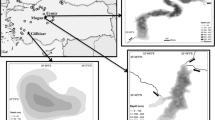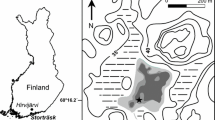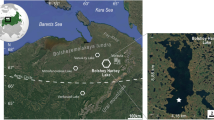Abstract
Our objective was to assess the potential of Cladocera from mountain lakes for climate reconstruction. We related Cladocera from surface sediments of Alpine lakes (1,502–2,309 m asl) to 29 abiotic environmental variables using statistical methods. The environmental dataset included water chemistry, lake depth, and bi-hourly water-temperature logs, which were used to assess mean monthly water temperatures, dates of freezing and breakup, spring and autumn mixing. We found 14 different Cladocera of the families Bosminidae, Daphniidae, and Chydoridae. Lakes without Cladocera (eight lakes) were cold and/or ultra-oligotrophic, whereas lakes with planktonic and littoral Cladocera (19 lakes) were warmer and/or less oligotrophic. Lakes with only littoral Cladocera (18 lakes) had intermediate water temperatures/trophy. Changes in Cladocera assemblages were related to changes in climate, nutrients, and/or alkalinity. We found a climate threshold at which Bosminidae disappeared in 95% of the lakes. For climate-change research, we propose studying Cladocera along transects that include climatic thresholds.


Similar content being viewed by others
References
Barry, R. G., 2001. Mountain Weather and Climate. Routledge, London.
Battarbee, R. W., 2000. Palaeolimnological approaches to climate change, with special regard to the biological record. Quaternary Science Reviews 19: 107–124.
Battarbee, R. W., J. A. Grytnes, R. Thompson, P. G. Appleby, J. Catalan, A. Korhola, H. J. B. Birks, E. Heegaard & A. Lami, 2002. Comparing palaeolimnological and instrumental evidence of climate change for remote mountain lakes over the last 200 years. Journal of Paleolimnology 28: 161–179.
Bennett, K. D., 1996. Determination of the number of zones in a biostratigraphical sequence. New Phytologist 132: 155–170.
Birks, H. J. B., 1995. Quantitative palaeoenvironmental reconstructions. In Maddy, D. & J. S. Brew (eds), Statistical Modeling of Quaternary Science Data. Technical Guide 5. Quaternary Research Association, Cambridge, 161–254.
Birks, H. J. B. & A. D. Gordon, 1985. Numerical Methods in Quaternary Pollen Analysis. Academic Press, London.
Bos, D. G. & B. F. Cumming, 2003. Sedimentary cladoceran remains and their relationship to nutrients and other limnological variables in 53 lakes from British Columbia, Canada. Canadian Journal of Fisheries and Aquatic Sciences 60: 1177–1189.
Bottrell, H. H., 1975. Generation time, length of instar, instar duration and frequency of moulting, and their relationship to temperature in eight species of Cladocera from the River Thames, Reading. Oecologia 19: 129–140.
Bradley, R. S., 2000. Past global changes and their significance for the future. Quaternary Science Reviews 19: 391–402.
Catalan, J., M. Ventura, A. Brancelj, I. Granados, H. Thies, U. Nickus, A. Korhola, A. F. Lotter, A. Barbieri, E. Stuchlík, L. Lien, P. Bitušík, T. Buchaca, L. Camarero, G. H. Goudsmit, J. Kopáćek, G. Lemcke, D. M. Livingstone, B. Müller, M. Rautio, M. Šiško, S. Sorvari, F. Šporka, O. Strunecký & M. Toro, 2002. Seasonal ecosystem variability in remote mountain lakes: implications for detecting climatic signals in sediment records. Journal of Paleolimnology 28: 25–46.
Cummings, M. P., D. S. Myers & M. Mangelson, 2004. Applying permutation tests to tree-based statistical models: extending the R package rpart. Technical Report CS-TR-4581, UMIACS-TR-2004-24. Center for Bioinformatics and Computational Biology, Institute for Advanced Computer Studies, University of Maryland.
Dufrêne, M. & P. Legendre, 1997. Species assemblages and indicator species: the need for a flexible asymmetrical approach. Ecological Monographs 67: 345–366.
Duigan, C. A., 1992. The ecology and distribution of the littoral freshwater Chydoridae (Branchiopoda, Anomopoda) of Ireland, with taxonomic comments on some species. Hydrobiologia 241: 1–70.
Duigan, C. A. & H. H. Birks, 2000. The late-Glacial and early-Holocene palaeoecology of cladoceran microfossil assemblages at Kråkenes, western Norway, with a quantitative reconstruction of temperature changes. Journal of Paleolimnology 23: 67–76.
Duigan, C. A. & W. L. Kovach, 1991. A study of the distribution and ecology of littoral freshwater Chydorid (Crustacea, Cladocera) communities in Ireland using multivariate analyses. Journal of Biogeography 18: 267–280.
Flössner, D., 1972. Branchiopoda, Branchiura. Tierwelt Deutschlands 60: 1–501.
Flössner, D., 2000. Die Haplopoda und Cladocera (ohne Bosminidae) Mitteleuropas. Backhuys Publishers, Leiden.
Frey, D. G., 1964. Remains of animals in Quaternary lake and bog sediments and their interpretation. Archiv für Hydrobiologie, Supplement Ergebnisse der Limnologie 2: 1–116.
Frey, D. G., 1986. Cladocera analysis. In Berglund, B. E. (eds), Handbook of Holocene Palaeoecology and Palaeohydrology. John Wiley & Sons, Chichester, 667–692.
Frey, D. G., 1988. Littoral and offshore communities of diatoms, cladocerans and dipterous larvae, and their interpretation in paleolimnology. Journal of Paleolimnology 1: 179–191.
Frey, D. G., 1991. First subfossil records of Daphnia headshields and shells (Anomopoda, Daphniidae) about 10,000 years old from northernmost Greenland, plus Alona guttata (Chydoridae). Journal of Paleolimnology 6: 193–197.
Goulden, C. E. & D. G. Frey, 1963. The occurrence and significance of lateral head pores in the genus Bosmina (Cladocera). Internationale Revue der gesamten Hydrobiologie 48: 513–522.
Gąsiorowski, M. & K. Szeroczyńska, 2004. Abrupt changes in Bosmina (Cladocera, Crustacea) assemblages during the history of the Ostrowite lake (northern Poland). Hydrobiologia 526: 137–144.
Harmsworth, R. V., 1968. The developmental history of Blelham Tarn (England) as shown by animal microfossils, with special reference to the Cladocera. Ecological Monographs 38: 223–241.
Hausmann, S., A. F. Lotter, J. F. N. van Leeuwen, C. Ohlendorf, G. Lemcke, E. Grönlund & M. Sturm, 2002. Interactions of climate and land use documented in the varved sediments of Seebergsee in the Swiss Alps. The Holocene 12: 279–289.
Heiri, O., A. F. Lotter, S. Hausmann & F. Kienast, 2003. A chironomid-based Holocene summer air temperature reconstruction from the Swiss Alps. The Holocene 13: 477–484.
Hessen, D. O. & N. A. Rukke, 2000. The costs of moulting in Daphnia; mineral regulation of carbon budgets. Freshwater Biology 45: 169–178.
Hofmann, W., 1986. Developmental history of the Grosser Plöner See and the Schönsee (north Germany): cladoceran analysis, with special reference to eutrophication. Archiv für Hydrobiologie, Supplement 74: 259–287.
Hofmann, W., 1987. Cladocera in space and time – analysis of lake-sediments. Hydrobiologia 145: 315–321.
Hofmann, W., 1996. Empirical relationships between cladoceran fauna and trophic state in thirteen northern German lakes: analysis of surficial sediments. Hydrobiologia 318: 195–201.
Hofmann, W., 1998. Cladocerans and chironomids as indicators of lake level changes in north temperate lakes. Journal of Paleolimnology 19: 55–62.
Hofmann, W., 2000. Response of the chydorid faunas to rapid climatic changes in four Alpine lakes at different altitudes. Palaeogeography, Palaeoclimatology, Palaeoecology 159: 281–292.
Hofmann, W., 2001. Late-Glacial/Holocene succession of the chironomid and cladoceran fauna of the Soppensee (Central Switzerland). Journal of Paleolimnology 25: 411–420.
Hofmann, W., 2003. The long-term succession of high-altitude cladoceran assemblages: a 9,000-year record from Sägistalsee (Swiss Alps). Journal of Paleolimnology 30: 291–296.
Jackson, D. A., 1993. Stopping rules in principal components analysis: a comparison of heuristical and statistical approaches. Ecology 74: 2204–2214.
Jeppesen, E., J. P. Jensen, T. L. Lauridsen, S. L. Amsinck, K. Christoffersen, M. Sondergaard & S. F. Mitchell, 2003. Sub-fossils of cladocerans in the surface sediments of 135 lakes as proxies for community structure of zooplankton, fish abundance and lake temperature. Hydrobiologia 491: 321–330.
Kamenik, C., K. A. Koinig, R. Schmidt, P. G. Appleby, J. A. Dearing, A. Lami, R. Thompson & R. Psenner, 2000. Eight-hundred years of environmental changes in a high alpine lake (Gossenköllesee, Tyrol) inferred from sediment records. Journal of Limnology 59: 43–52.
Kamenik, C. & R. Schmidt, 2005. Chrysophyte resting stages: a tool for reconstructing winter/spring climate from Alpine lake sediments. Boreas 34: 477–489.
Kamenik, C., R. Schmidt, G. Kum & R. Psenner, 2001. The influence of catchment characteristics on the water chemistry of mountain lakes. Arctic, Antarctic and Alpine Research 33: 404–409.
Korhola, A., 1999. Distribution patterns of Cladocera in subarctic Fennoscandian lakes and their potential in environmental reconstruction. Ecography 22: 357–373.
Korhola, A. & M. Rautio, 2001. Cladocera and other branchiopod crustaceans. In: Smol, J. P., H. J. B. Birks, & W. M. Last (eds), Tracking Environmental Change Using Lake Sediments. Volume 4: Zoological Indicators. Kluwer Academic Publishers, Dordrecht, 5–41.
Korhola, A., M. Tikkanen & J. Weckström, 2005. Quantification of Holocene lake-level changes in Finnish Lapland using a cladocera – lake depth transfer model. Journal of Paleolimnology 34: 175–190.
Legendre, P. & L. Legendre, 1998. Numerical Ecology. Elsevier, Amsterdam.
Lepš, J. & P. Šmilauer, 2003. Multivariate Analysis of Ecological Data Using CANOCO. Cambridge University Press, Cambridge.
Lotter, A. F. & H. J. B. Birks, 2003. The Holocene palaeolimnology of Sägistalsee and its environmental history – a synthesis. Journal of Paleolimnology 30: 333–342.
Lotter, A. F., H. J. B. Birks, U. Eicher, W. Hofmann, J. Schwander & L. Wick, 2000. Younger Dryas and Allerød summer temperatures at Gerzensee (Switzerland) inferred from fossil pollen and cladoceran assemblages. Palaeogeography, Palaeoclimatology, Palaeoecology 159: 349–361.
Lotter, A. F., H. J. B. Birks, W. Hofmann & A. Marchetto, 1997. Modern diatom, cladocera, chironomid, and chrysophyte cyst assemblages as quantitative indicators for the reconstruction of past environmental conditions in the Alps. I. Climate. Journal of Paleolimnology 18: 395–420.
Lotter, A. F., H. J. B. Birks, W. Hofmann & A. Marchetto, 1998. Modern diatom, cladocera, chironomid, and chrysophyte cyst assemblages as quantitative indicators for the reconstruction of past environmental conditions in the Alps. II. Nutrients. Journal of Paleolimnology 19: 443–463.
Lotter, A. F. & S. Juggins, 1991. POLPROF, TRAN and ZONE: programs for plotting, editing and zoning pollen and diatom data. INQUA-Subcommission for the study of the Holocene Working Group on Data-Handling Methods, Newsletter 6: 4–6.
Manca, M. & M. Armiraglio, 2002. Zooplankton of 15 lakes in the southern Central Alps: comparison of recent and past (pre-ca 1850 AD) communities. Journal of Limnology 61: 225–231.
Meijering, M. P. D., 1983. On the occurrence of ‘arctic’ Cladocera with special reference to those along the Strait of Belle Isle (Quebec, Labrador, Newfoundland). Internationale Revue der gesamten Hydrobiologie 68: 885–893.
Milecka, K. & K. Szeroczyńska, 2005. Changes in macrophytic flora and planktonic organisms in Lake Ostrowite, Poland, as a response to climatic and trophic fluctuations. Holocene 15: 74–84.
Moberg, A., D. M. Sonechkin, K. Holmgren, N. M. Datsenko & W. Karlen, 2005. Highly variable northern hemisphere temperatures reconstructed from low- and high-resolution proxy data. Nature 433: 613–617.
Müller, W. P., 1964. The distribution of cladoceran remains in surficial sediments from three northern Indiana lakes. Investigations of Indiana Lakes & Streams 6: 1–63.
Plath, K. & M. Boersma, 2001. Mineral limitation of zooplankton: stochiometric constraints and optimal foraging. Ecology 82: 1260–1269.
Rautio, M., 1998. Community structure of crustacean zooplankton in subarctic ponds – effects of altitude and physical heterogeneity. Ecography 21: 327–335.
Rautio, M., 2001. Zooplankton assemblages related to environmental characteristics in treeline ponds in Finnish Lapland. Arctic, Antarctic and Alpine Research 33: 289–298.
Sandøy, S. & J. P. Nilssen, 1986. A geographical survey of littoral Crustacea in Norway and their use in paleolimnology. Hydrobiologia 143: 277–286.
Sarmaja-Korjonen, K. & P. Alhonen, 1999. Cladoceran and diatom evidence of lake-level fluctuations from a Finnish lake and the effect of aquatic-moss layers on microfossil assemblages. Journal of Paleolimnology 22: 277–290.
Sarmaja-Korjonen, K., S. Kultti, N. Solovieva & M. Valiranta, 2003. Mid-Holocene palaeoclimatic and palaeohydrological conditions in northeastern European Russia: a multi-proxy study of Lake Vankavad. Journal of Paleolimnology 30: 415–426.
Schmidt, R., C. Kamenik, C. Kaiblinger & M. Hetzel, 2004a. Tracking Holocene environmental changes in an alpine lake sediment core: application of regional diatom calibration, geochemistry, and pollen. Journal of Paleolimnology 32: 177–196.
Schmidt, R., C. Kamenik, H. Lange-Bertalot & R. Klee, 2004b. Fragilaria and Staurosira (Bacillariophyceae) from sediment surfaces of 40 lakes in the Austrian Alps in relation to environmental variables, and their potential for palaeoclimatology. Journal of Limnology 63: 171–189.
Schulz, K. L. & R. W. Sterner, 1999. Phytoplankton phosphorus limitation and food quality for Bosmina. Limnology and Oceanography 44: 1549–1556.
Sterner, R. W., D. D. Hagemeier & W. L. Smith, 1993. Phytoplankton nutrient limitation and food quality for Daphnia. Limnology and Oceanography 38: 857–871.
Stumm, W. & J. J. Morgan, 1996. Aquatic Chemistry: Chemical Equilibria and Rates in Natural Waters. John Wiley & Sons, Inc., New York.
Szeroczyńska, K., 1984. Analiza Cladocera w osadach niektórych jezior tatrzańskich (Results of examination of Cladocera remains in lacustrine sediments of Dolina Pięciu Stawów Polskich). Prace i Studia Geograficzne 5: 93–110.
Szeroczyńska, K., 1998a. Cladocera analysis in the Late-Glacial sediments of the Lake Gościąž, Central Poland. In: Ralska-Jasiewiczowa, M., T. Goslar, T. Madeyska, & L. Starkel (eds), Lake Gościąž, Central Poland. A Monographic Study. W. Szafer Institute of Botany, Polish Academy of Sciences, Kraków, 148–158.
Szeroczyńska, K., 1998b. Palaeolimnological investigations in Poland based on Cladocera (Crustacea). Palaeogeography, Palaeoclimatology. Palaeoecology 140: 335–345.
Szeroczyńska, K., 2002. Human impact on lakes recorded in the remains of Cladocera (Crustacea). Quaternary International 95–96: 165–174.
ter Braak, C. J. F., 1987. The analysis of vegetation–environment relationships by Canonical Correspondence Analysis. Vegetatio 69: 69–77.
ter Braak, C. J. F. & S. Juggins, 1993. Weighted Averaging Partial Least Squares Regression (WA-PLS): an improved method for reconstructing environmental variables from species assemblages. Hydrobiologia 269/270: 485–502.
ter Braak, C. J. F. & C. W. N. Looman, 1986. Weighted averaging, logistic regression and the Gaussian response model. Vegetatio 65: 3–11.
ter Braak, C. J. F. & P. Šmilauer, 2002. CANOCO reference manual and CanoDraw for Windows user’s guide: software for canonical community ordination (version 4.5). Microcomputer Power, Ithaca NY, USA.
Thompson, R., C. Kamenik & R. Schmidt, 2005. Ultra-sensitive Alpine lakes and climate change. Journal of Limnology 64: 139–152.
Urabe, J., J. Clasen & R. W. Sterner, 1997. Phosphorus limitation of Daphnia growth: is it real? Limnology and Oceanography 42: 1436–1443.
Venables, W. N. & B. D. Ripley, 2002. Modern Applied Statistics with S. Springer, New York.
Venables, W. N. & D. M. Smith, 2002. An Introduction to R. Network Theory Ltd., Bristol.
Whiteside, M. C. & R. V. Harmsworth, 1967. Species diversity in chydorid (Cladocera) communities. Ecology 48: 664–667.
Whiteside, M. C. & M. R. Swindoll, 1988. Guidelines and limitations to cladoceran paleoecological interpretations. Palaeogeography, Palaeoclimatology, Palaeoecology 62: 405–412.
Williamson, C. E., O. G. Olson, S. E. Lott, N. D. Walker, D. R. Engstrom & B. R. Hargreaves, 2001. Ultraviolet radiation and zooplankton community structure following deglaciation in Glacier Bay, Alaska. Ecology 82: 1748–1760.
Winder, M., M. T. Monaghan & P. Spaak, 2001. Have human impacts changed Alpine zooplankton diversity over the past 100 years? Arctic, Antarctic and Alpine Research 33: 467–475.
Wright, S. P., 1992. Adjusted P-values for simultaneous inference. Biometrics 48: 1005–1013.
Acknowledgments
We would like to thank P. Indinger and numerous volunteers for their help in the field. H. Höllerer and J. Knoll for technical assistance, B. Franzoi and W. Müller for chemical analyses, G. Kum for lake surface-area measurements, three anonymous reviewers for helpful comments, J. Kaplan for correcting the English, and E. Slezak for her support while writing the manuscript. This study was funded by the Austrian Science Fund (FWF, project no. P14912-B06).
Author information
Authors and Affiliations
Corresponding author
Additional information
Guest editor: Piet Spaak
Cladocera: Proceedings of the 7th International Symposium on Cladocera
Rights and permissions
About this article
Cite this article
Kamenik, C., Szeroczyńska, K. & Schmidt, R. Relationships among recent Alpine Cladocera remains and their environment: implications for climate-change studies. Hydrobiologia 594, 33–46 (2007). https://doi.org/10.1007/s10750-007-9083-4
Published:
Issue Date:
DOI: https://doi.org/10.1007/s10750-007-9083-4




